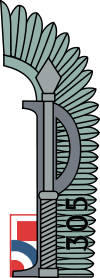No. 305 Polish Bomber Squadron
| No. 305 (Ziemia Wielkopolska) Polish Bomber Squadron | |
|---|---|
|
305 Squadron logo | |
| Active | 29 August 1940 – 6 January 1947 |
| Country |
|
| Allegiance |
|
| Branch |
|
| Role | Bomber Squadron |
| Part of |
RAF Bomber Command Second Tactical Air Force |
| Commanders | |
| Notable commanders | Bolesław Orliński |
| Insignia | |
| Squadron Codes | SM (Aug 1940 – Jan 1947) |
No. 305 Polish Bomber Squadron "Ziemia Wielkopolska" ("Land of Greater Poland") (Polish: 305 Dywizjon Bombowy "Ziemi Wielkopolskiej im. Marszałka Józefa Piłsudskiego") was a Polish World War II bomber unit.
History
The last of the Polish bomber squadrons, 305 Squadron was formed at RAF Bramcote, Warwickshire on 29 August 1940. It was initially equipped with the somewhat obsolete Fairey Battle aircraft, but was reequipped in November 1940 with twin-engine Vickers Wellington heavy bombers. The unit began operational flying in April 1941. Its first mission was bombing of petrol and fuel storage tanks at Rotterdam in the night from 25 to 26 April 1941.[1] Between June 1941 and August 1943 the Squadron was based at RAF Ingham.
In August 1943, the Squadron was moved to RAF Swanton Morley and thereafter ceased its affiliation with RAF Bomber Command; instead, it was absorbed into the freshly formed Second Tactical Air Force, a specialized arm of the RAF that was centered on tactical air strikes on vital enemy targets (such as bridges, supply trains, etc.) on the Continent.
During this period, 305 Squadron was transferred to No. 2 Group RAF[2] and converted briefly to North American Mitchell medium bombers before adopting the De Havilland Mosquito FB.VI, the aircraft that the Squadron operated for the remainder of the European campaign. Through 1944, the 305 was stationed at RAF Lasham in England and then briefly at RAF Hartford Bridge before moving to the Epinoy airfield in France in November 1944. The squadron did, amongst other sorties, during the Normandy Landings, destroy 13,000,000 liters of the German fuel stored near Nancy, France. The squadron flew its last action exactly four years after their first, in the night from 25 to 26 April 1945.[1] After the hostilities ended, the Squadron continued to operate in Germany as part of the occupation forces and, after a brief return to England, was finally disbanded formally on 6 January 1947 at RAF Faldingworth, having already given up its aircraft on 25 November 1946.[1]
Aircraft operated
| From | To | Aircraft | Version |
|---|---|---|---|
| September 1940 | November 1940 | Fairey Battle | Mk.I |
| November 1940 | July 1941 | Vickers Wellington | Mk.Ic |
| July 1941 | August 1942 | Vickers Wellington | Mk.II |
| August 1942 | May 1943 | Vickers Wellington | Mk.IV |
| May 1943 | September 1943 | Vickers Wellington | Mk.X |
| September 1943 | October 1943 | North American Mitchell | Mk.II |
| December 1943 | November 1946 | de Havilland Mosquito | FB.VI |
See also
References
Notes
Bibliography
- Halley, James J. The Squadrons of the Royal Air Force & Commonwealth, 1918–1988. Tonbridge, Kent, UK: Air-Britain (Historians) Ltd., 1988. ISBN 0-85130-164-9.
- Jefford, Wing Commander C.G., MBE, BA, RAF (Retd). RAF Squadrons, a Comprehensive Record of the Movement and Equipment of all RAF Squadrons and their Antecedents since 1912. Shrewsbury: Airlife Publishing, 2001. ISBN 1-84037-141-2.
- Moyes, Philip J.R. Bomber Squadrons of the RAF and their Aircraft. London: Macdonald and Jane's (Publishers) Ltd., 1964 (new edition 1974). ISBN 0-354-01027-1.
- Zieliński, Józef. 305 Dywizjon Bombowy Ziemi Wielkopolskiej I Lidzkiej. Dom Wydawniczy Bellona. ISBN 83-11-09813-1. (In Polish)
External links
| Wikimedia Commons has media related to No. 305 (Polish) Squadron RAF. |
- 305 Squadron Living History Group
- Photo Gallery of 305 Squadron
- Personnel of the Polish Air Force in Great Britain 1940-1947
